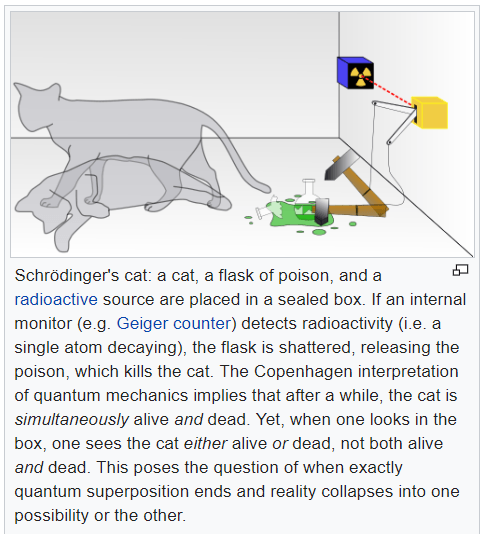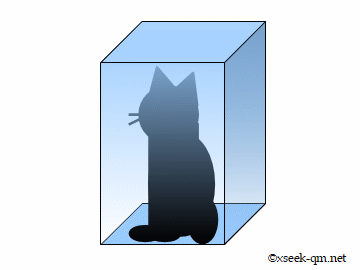

The Copenhagen interpretation is used to explain what is happening to the smallest part of an atom (a sub atomic particle) without looking at it (observing it or measuring it). Quantum mechanics provides a way for physicists to explain why these things happen. However, there are some physical interactions which it does not explain for instance, how light can be turned into electricity. It can also be used to predict physical interactions, like what will happen when you drop a ball. Classic physics explains most physical interactions, like why a ball bounces when it drops. Physics can be divided into two types classic physics and quantum mechanics.

No one knows if any scientific theory is right or wrong until said theory can be tested and proved. This is used to represent how scientific theory works. In simple terms, Schrödinger stated that if you place a cat and something that could kill the cat (a radioactive atom) in a box and sealed it, you would not know if the cat was dead or alive until you opened the box, so that until the box was opened, the cat was (in a sense) both "dead and alive". Trimmer in Proceedings of the American Philosophical Society) Erwin Schrödinger, Die gegenwärtige Situation in der Quantenmechanik (The present situation in quantum mechanics), Naturwissenschaften There is a difference between a shaky or out-of-focus photo and a snapshot of clouds and fog banks. In itself, it would not embody anything unclear or contradictory.

That prevents us from so naively accepting as valid a "blurred model" for representing reality. It is typical of these cases that an indeterminacy originally restricted to the atomic domain becomes transformed into macroscopic indeterminacy, which can then be resolved by direct observation. The psi-function of the entire system would express this by having in it the living and dead cat (pardon the expression) mixed or smeared out in equal parts. If one has left this entire system to itself for an hour, one would say that the cat still lives if meanwhile no atom has decayed. A cat is locked up in a steel chamber, along with the following device (which must be secured against direct interference by the cat): in a Geiger counter, there is a tiny bit of radioactive substance, so small, that perhaps in the course of an hour only one of the atoms decays, but also, with equal probability, perhaps none if it happens, the counter tube discharges and through a relay releases a hammer that shatters a small flask of hydrocyanic acid. One can even set up quite ridiculous cases. Erwin Schrödinger suggested it in 1935, in reaction to the Copenhagen interpretation of quantum physics. Schrödinger's cat is a thought experiment about quantum physics.

Depending on the light conditions, the cat appears either alive or dead. Only once the whole experiment is observed would the cat be decidedly alive or dead.Real-size cat figure in the garden of Huttenstrasse 9, Zurich, where Erwin Schrödinger lived 1921 – 1926. According to the Copenhagen Interpretation, the undecided position of a particle colliding with the counter would both hit and not hit it at any one moment, meaning the hidden cat would both be killed and not killed. This device featured a radioactive material by a Geiger counter set to trigger the destruction of a vial of deadly acid the moment it is affected by a particles' decay. "A cat is locked up in a steel chamber, along with the following device …" "One can even set up quite ridiculous cases," Schrödinger wrote. In an essay titled The present situation in quantum mechanics he criticised such strange definitions of probability by posing an experiment that connected the uncertainty of a particle's unobserved property with something we can all relate to and empathise with – the living state of a small animal. Notable physicists such as Albert Einstein opposed this interpretation, claiming quantum physics was an incomplete theory and future work would reveal what those waves really were.Įrwin Schrödinger agreed. In other words, properties weren't defined in any meaningful sense until they were measured in some way by an experiment. Certain implications of this 'probability' description – referred to as the Copenhagen interpretation – considered reality as unsettled until it was part of a system we could observe.


 0 kommentar(er)
0 kommentar(er)
